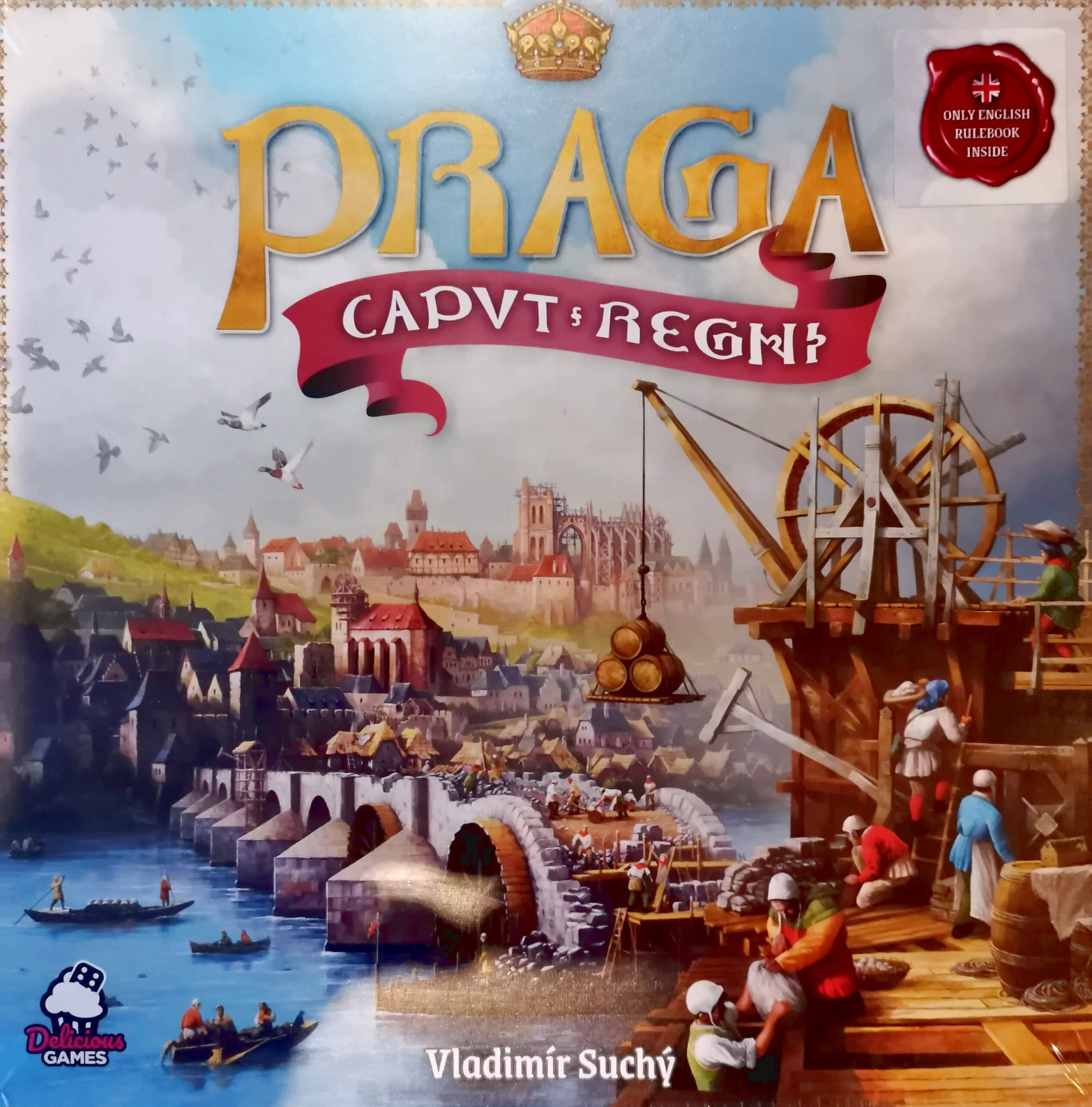Vladimír Suchý is back with a lavish new Euro – Praga Caput Regni. Moving back to terra firma after his most-recent outings to space (Pulsar 2849) and the bottom of the ocean (Underwater Cities), do you have what it takes to develop medieval Prague?
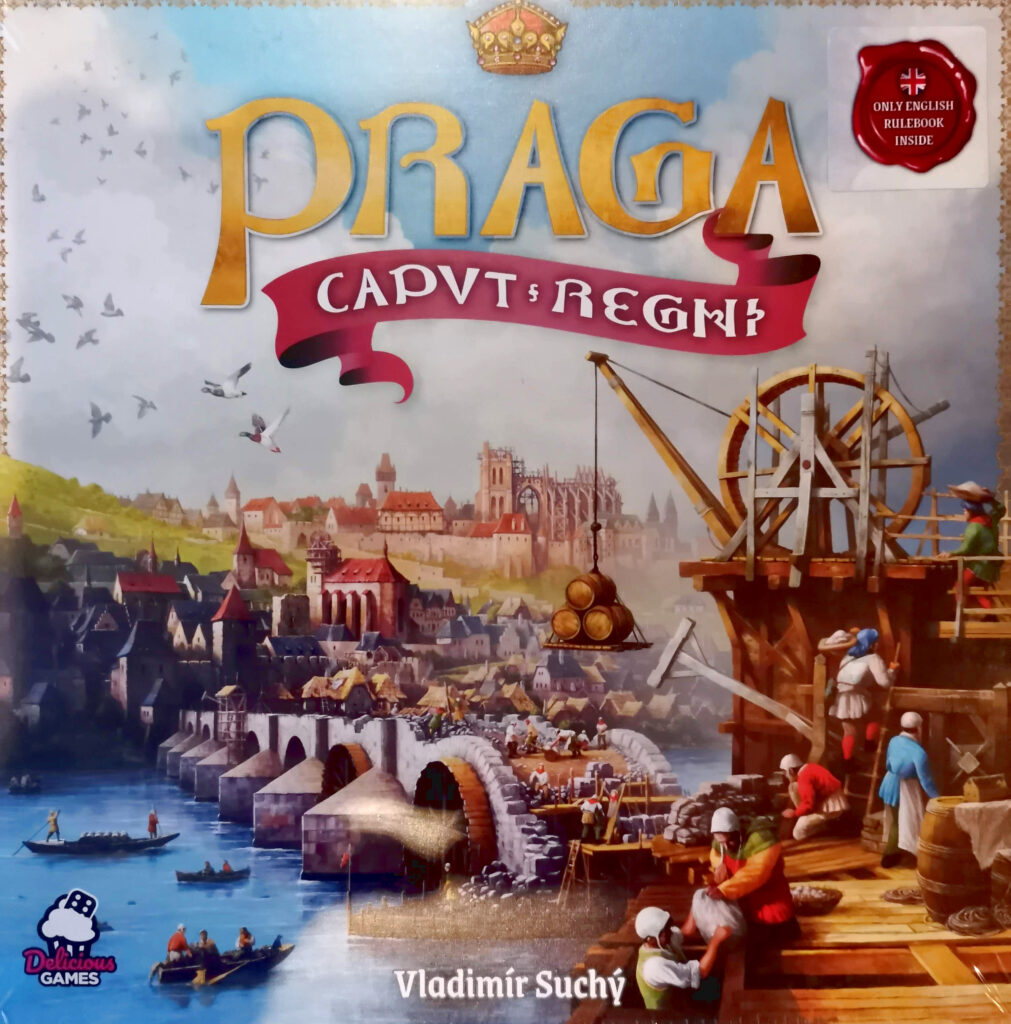
Ever since I saw the action wheel on the main board for Praga Caput Regni (which loosely translates to ‘Prague, Capital of the Kingdom) I got excited for this game. I’m a sucker for a new mechanic, even if it’s just a new way of doing something that’s been done before. Vladimir’s name on the box, the bright colourful artwork, and a historical Euro game; what’s not to love? Well, there needs to be a good game under the gloss and gimmicks, so let’s see.
What’s In The Box?
Praga Caput Regni has a ton of stuff in the box, and some construction needed. The player boards fold over and have two point-tracking wheels (cranes) and some nice sockets for holding cubes in place.
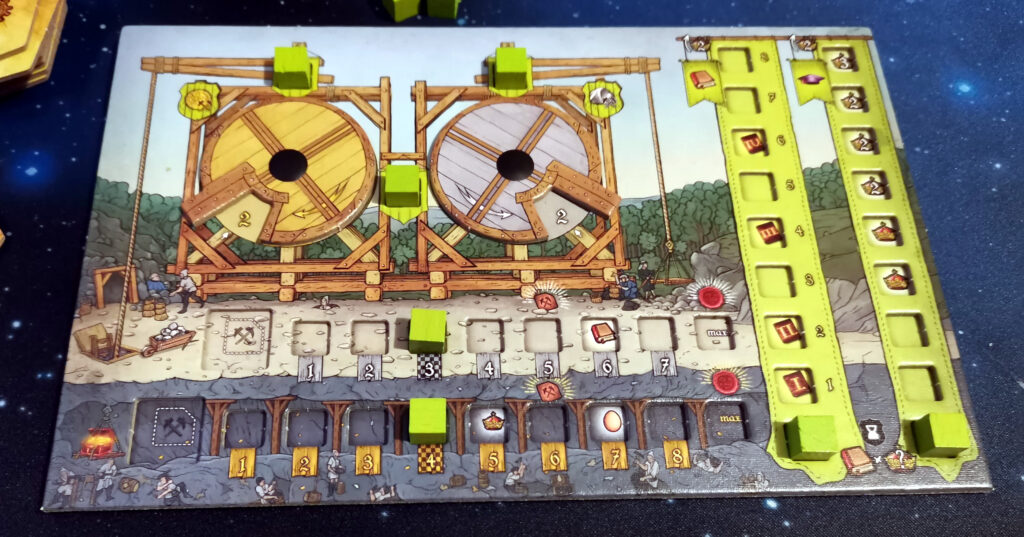
The main board has the action wheel I mentioned above, and there are three little structures to build, which the instructions recommend gluing to keep them together. There’s a little model of Prague’s Charles Bridge, along with some terraces which represent the city’s St Vitus Cathedral and the Hunger Wall.
The board is pretty huge, and really bright and colourful, and there are a lot of hex tiles to punch, which make up the walls, buildings and technologies you’ll be developing during the game. There are tiles to randomly place for plazas to build around, and a really nice touch is the inclusion of double sided tiles you can use to replace the Kings Road area of the board, the spaces available on the Charles Bridge, and also the tiers on the Cathedral and Hunger Wall. The action tiles, which drive the main mechanics of the game are also double-sided.
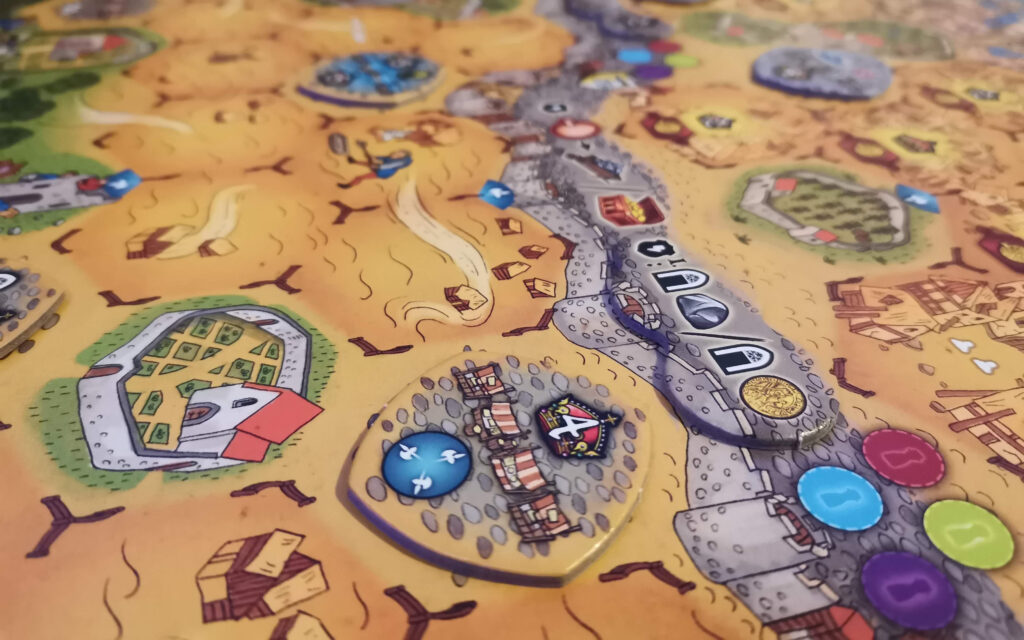
Players have a selection of cubes in their own colour along with a scoring disc and a pawn with a little hat. The production values of all the components is really high quality, although my player boards’ printing is skewed (which apparently Delicious Games, the publishers, will replace), and the game box itself is thinner cardboard than nearly every game in my collection.
How Does It Play?
On first sight, the board for Praga Caput Regni is confusing. There’s a lot going on, and the bright colours and pretty illustrations make it hard to visually delineate the different areas. When you’re dealing with a pretty heavy euro, that immediately makes things a little daunting. However, persevere with setup and the first few turns, and it soon makes sense.
The Crane
The big action wheel on the main board is referred to as the crane. The start and end of every turn involve taking an action tile from the wheel, and putting it back, respectively. The tiles further clockwise around the wheel (and therefore older) are free to take, and can even give you VPs if they move far enough around. At the end of your turn, the wheel gets rotated one space, and your used tile goes at the back-most space. You can take recently-used tiles too, but these will cost you gold to take.
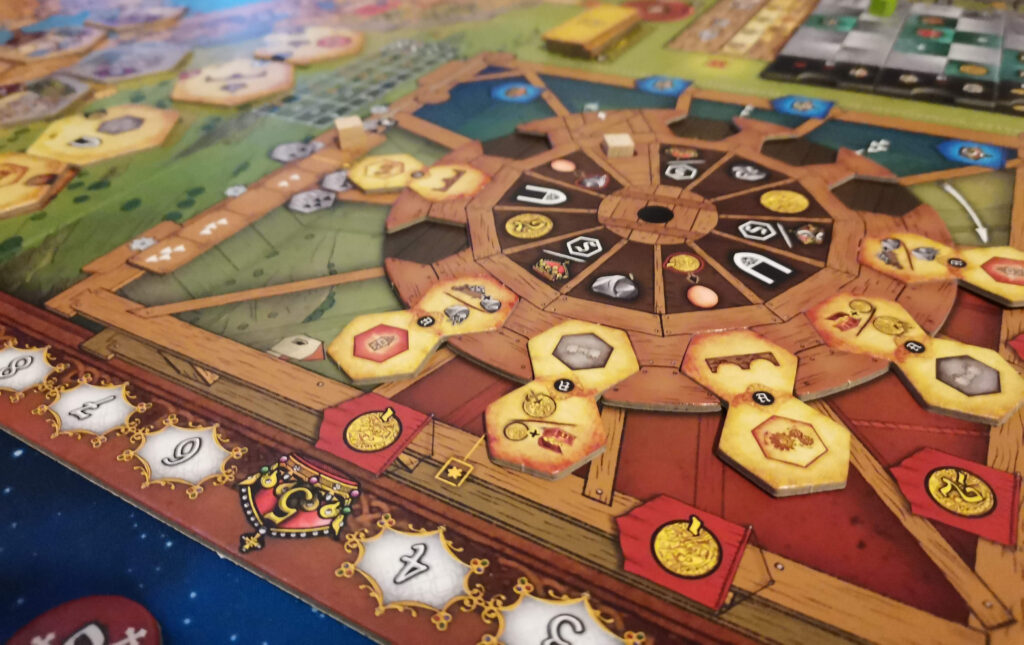
So you’ve taken your tile, but what can you do? Each tile has two actions on it, and you can pick either. The actions let you: build a building, add a wall around your action board, upgrade a technology on your action board, advance along the Kings Road, or use or develop your stone quarries or gold mines. You choose which you want to do, pay the requisite resources, perform the action, and then it’s the next player’s turn. That’s the very concise version of a turn.
The Brain
With this being a heavier game from the mind of Suchý, you can be sure there’s plenty going on. There are links and cascading effects between all of the different things you can do, and a seemingly huge number of ways to go after points. Building buildings can give you big bonuses from surrounding plazas, and can advance you along the cathedral. Or maybe you decide to construct wall tiles around your action board, advancing you on the Hunger Wall, and combining for big end-of-game bonuses. Speaking of action boards, you can overlay upgrade tiles on it so that when you take certain actions, you gain bonuses.

Then again, you could choose to move along the King’s Road, collecting bonuses with an aim to place planks on the bridge, giving more bonuses and game-end bonuses. And that’s all without even looking at your player board. Increasing the yield from your quarries and mines means unlocking more bonuses each time you choose to get resources, and if you collect enough of either gold or stone, you unlock more cubes, to claim more buildings, and removing those cubes from your board gives you even more bonuses.
And then there’s technologies. And the University track. Oh, and the bonuses you get for taking actions from particular places on the wheel. Did I forget to mention there’s bonus tiles alone the river which, once claimed, get added to your player board to get you even more things and points when you use your mines and quarries? Or the matching corners on tiles that give you points to multiply at the end of the game? Or gold and silver windows to give bonus turns or wall and cathedral advancements? Or eggs?!? Yes, eggs.
Putting It All Together
There’s no way to explain all the way these things all work in a review. Hopefully though, I’ve managed to give you an idea of just how many things there are to consider with every turn you take. While there’s no direct player interaction, there’s plenty of indirect. The number of building spaces around each plaza differ, and managing to sneak in and claim the rewards is a great feeling that your friends will frown at you for. The available upgrades, buildings and walls are always in full view, and the bonuses for gaining a technology, or adding a plank to the bridge, are first come, first served.
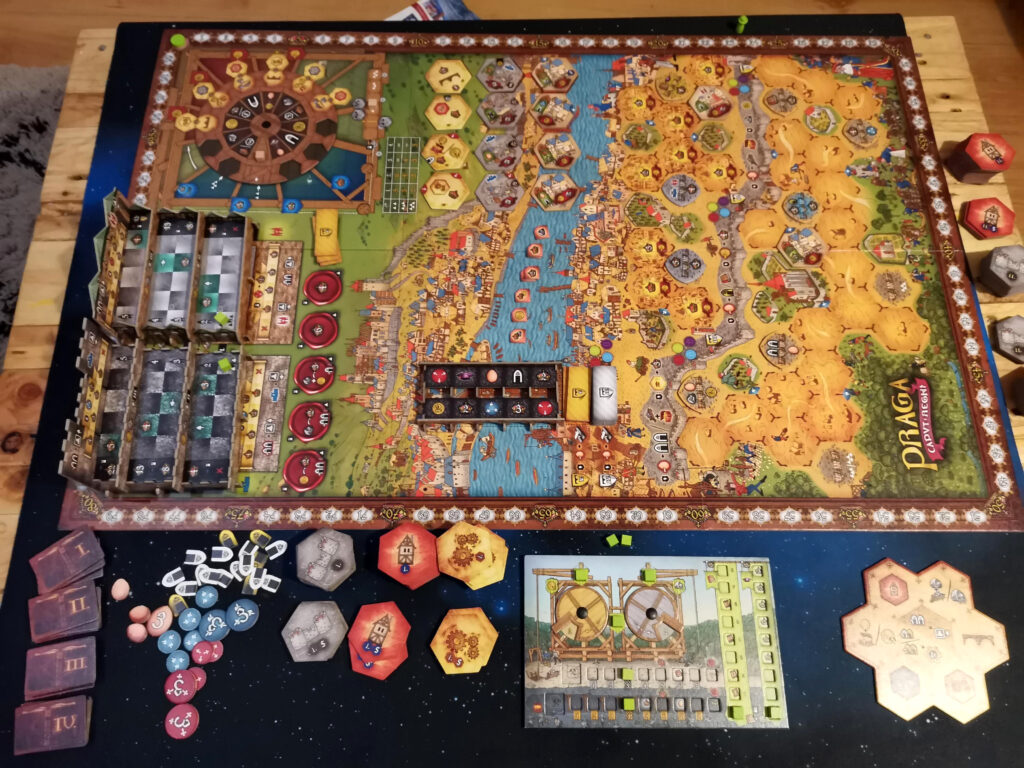
When all is said and done and the cube on the wheel drops through the little trapdoor on the main board for the final time (which helps track the rounds of the game) players total up their scores to see who King Charles’ favourite developer was.
Final Thoughts
Praga Caput Regni then. It does what the best heavy euros do: it makes very strategic planning and brain-melting decisions come from a very basic turn action. Choosing a tile, doing one of two actions, then putting the tile back sounds like it’s very simple. In truth, it is. But how you use that action, wow, that’s the puzzle, and that’s the beauty of this game.
Always Have a Plan B
There’s a real sense of focus on your own player board, and your action board. There’s constant mental bookkeeping as you plan ahead, and if you’re playing well, there’s very rarely an abundance of gold or stone to do nothing with. You’re looking at the tiles available, and your board, and making those stories in your head – “I’ve got enough gold to take that building, and if I do and put it next to that plaza, Ill get that gold window. If the building action tile I choose is from the slot on the wheel that gives a silver window, that’ll mean I can use those windows to take an extra turn, and I can use my mine gain more gold for the next turn. Oh boy, the perfect plan!”.
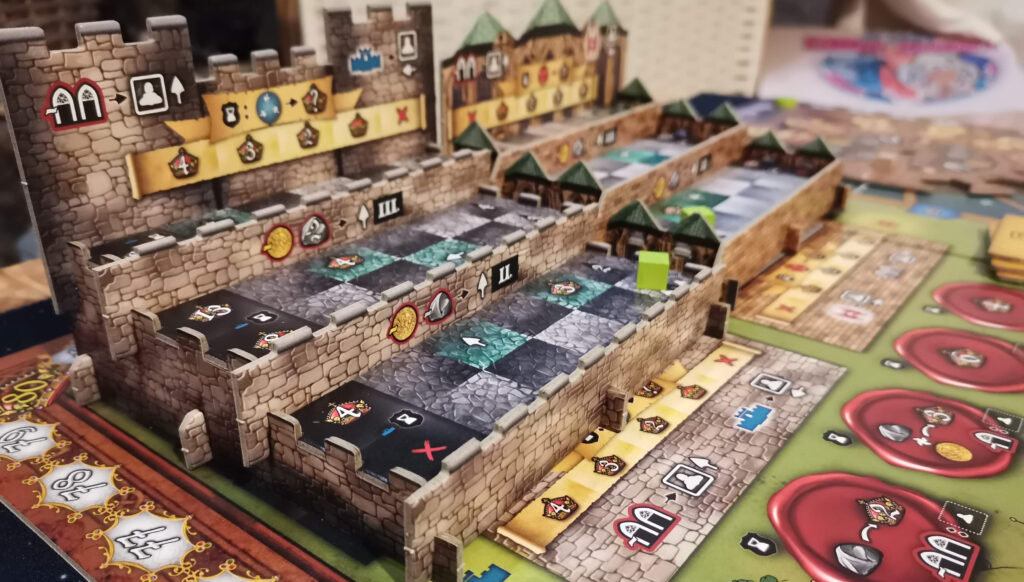
You know what comes next though. Someone else takes the building you wanted, and your plans are in tatters. And I love that in a game. Actually, more accurately, I love that in a game that does it well. There are so many legitimate ways to score and win in Praga Caput Regni, even if someone pulls the rug from under you. That’s balance, and that’s often the difference between a good and a mediocre game.
Fuss
Praga Caput Regni is very, very good. There are, however, a couple of things that stop it being extraordinary for me, and it’s just around fussy things. The board for one. It’s so bright and colourful, with so much going on, that even I found my first setup tricky. The bottom half of the board especially, it’s very difficult to see what’s a building space, what’s a plaza space, and what’s neither. It makes it hard to setup at first, and it means you need to concentrate to see how many spaces are occupied around a plaza, whereas in a game of this complexity you really need some information at-a-glance.
My other main bugbear is with the amount of tiles that need sorting and organising. There are three kinds of hex tiles: buildings, upgrades and walls. For each kind, there are two types: standard and special. These get sorted and stacked next to the board, so you have six piles. Halfway through the game though, you reach the second Era, and all of those tiles are replaced with more expensive, more powerful, higher-scoring variants of themselves. So you replace those six piles with six more.
As you can imagine, sorting all of those tiles out (102 in total) isn’t something you want to do every time you play, and it means separating them – for me at least – into 12 separate baggies. That’s before we even look at the other components.
These are relatively minor gripes in the grand scheme of things, but ones I think deserve mentioning.
A Labour Of Love
Despite my negative points above, I want to stress just how much I love this game. It feels like one that Vladimir clearly had close to his heart, with his own connections with the Czech Republic, and the game being set in historic Prague. The balance feels superb, and there’s no obvious runaway strategy. Each time I play, I can try something different. Sometimes it works, sometimes it doesn’t, but at no point does it feel unfair. If something doesn’t work, it’s because I’ve done something stupid.
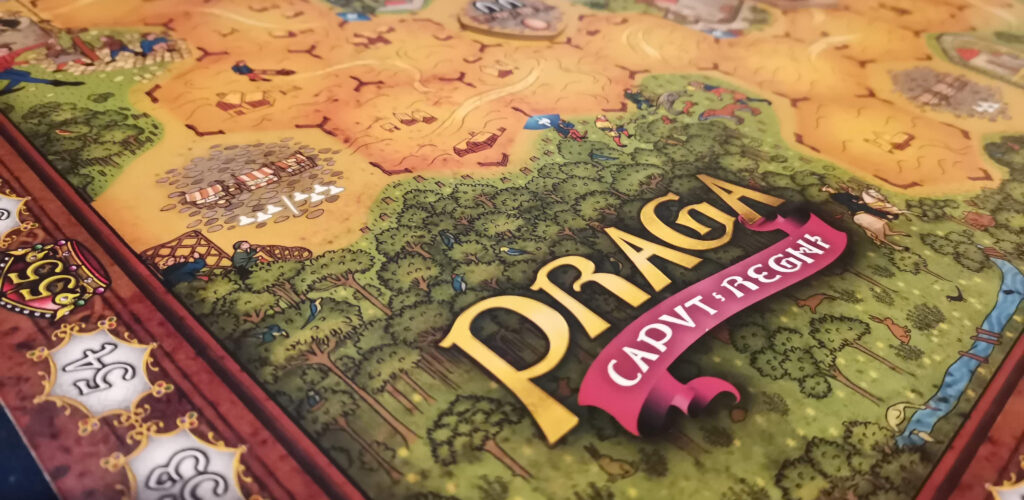
The biggest sign for me, personally, that a game ticks all the right boxes, is that as soon as I finish playing it, win or lose, I’m smiling, and immediately want to play again. That’s true of Praga Caput Regni. I’ve played back-to-back solo games quite a few times now. Partly because of the faff of set-up and tear-down as I mentioned above, but mostly because it’s a fantastic game.
Speaking of solo, there is a solitaire mode in the box. It’s a beat-your-own-score affair, which I know some people don’t like. In the rule book it mentions a downloadable solo variant called Peter Parler (a famous architect of the time), which wasn’t ready in time for the game’s publishing, but can be downloaded and printed for free. It’s really the only way to play solo, as without Peter placing buildings on the board, it’s nigh-on impossible to surround plazas on your own, which nullifies buildings to some extent. The 140 point target mentioned in the rule book is also almost impossible without Peter. I ended up making a web-based version of Peter’s deck, rather than print.
I absolutely love the feeling of combining the perfect set of actions and resources, and having your opponents watch on as you move pieces all over the board, racking up points. There’s no dice or cards, which eliminates a lot of randomness, and everything in the game is public knowledge throughout. There’s probably too much going on for casual players, but if you enjoy a busy Euro with a lot of choices and routes to victory, I think you’ll love Praga Caput Regni too.
